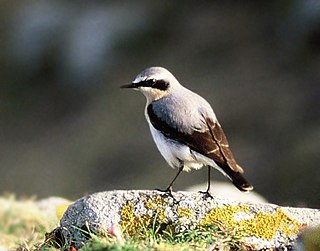
The wheatears are passerine birds of the genus Oenanthe. They were formerly considered to be members of the thrush family, Turdidae, but are now more commonly placed in the flycatcher family, Muscicapidae. This is an Old World group, but the northern wheatear has established a foothold in eastern Canada and Greenland and in western Canada and Alaska.

The New World warblers or wood-warblers are a group of small, often colorful, passerine birds that make up the family Parulidae and are restricted to the New World. The family contains 120 species. They are not closely related to Old World warblers or Australian warblers. Most are arboreal, but some, like the ovenbird and the two waterthrushes, are primarily terrestrial. Most members of this family are insectivores.
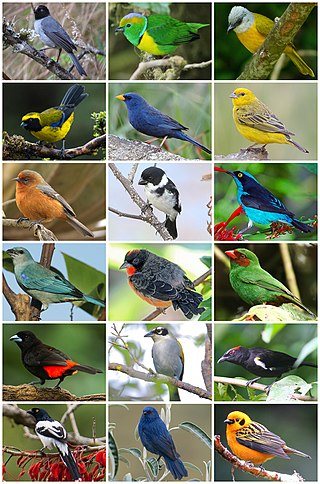
The tanagers comprise the bird family Thraupidae, in the order Passeriformes. The family has a Neotropical distribution and is the second-largest family of birds. It represents about 4% of all avian species and 12% of the Neotropical birds.

The summer tanager is a medium-sized American songbird. Formerly placed in the tanager family (Thraupidae), it and other members of its genus are now classified in the cardinal family (Cardinalidae). The species's plumage and vocalizations are similar to other members of the cardinal family.

Saltator is a genus of passerine birds in the tanager family Thraupidae that are found in Central and South America. They have thick bills, relatively long tails and strong legs and feet. Before the introduction of molecular genetic methods in the 21st century these species were placed in the cardinal family Cardinalidae.

The white-capped tanager is a South American bird in the tanager family Thraupidae. It is the only member of the genus Sericossypha. It is the heaviest but not the longest species of tanager, at a weight of 114 g (4 oz) and a length of 24 cm (9.5 in). This species is glossy black overall with a large white crown and a red throat. It occurs in Colombia, Venezuela, Ecuador and Peru at elevations of 1600–3200 m. It lives in humid Andean forest in groups of up to 20 individuals. Flocks of these tanagers stay in tight formation, often foraging from tree to tree together. They may eat fruits, seeds, hymenoptera, and coleoptera.
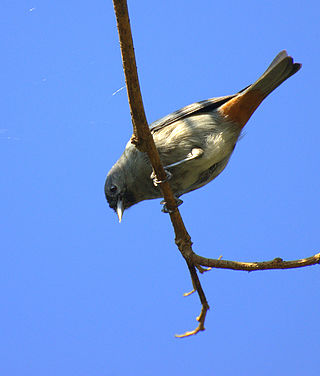
Typical conebills belong to the tanager genus Conirostrum. They are small tanagers (9–14 cm) found in the forests of South America. They feed in pairs or small flocks by gleaning insects from foliage.

Idiopsar is a genus of Neotropical seed-eating birds in the tanager family Thraupidae.

Thlypopsis is a genus of birds in the tanager family Thraupidae.

The chestnut-headed tanager is a species of bird in the tanager family Thraupidae this is found in the Atlantic Forest of southeast Brazil, eastern Paraguay and far northeastern Argentina. It was formerly the only member of the genus Pyrrhocoma but is now placed in Thlypopsis.

The orange-throated tanager is a species of bird in the tanager family Thraupidae that is found very locally in humid forests around the Ecuador-Peru border. As a species it is considered threatened. The orange-throated tanager is the only member of the genus Wetmorethraupis, named after the ornithologist Alexander Wetmore. It is closely related to members of the genus Bangsia.

Camarhynchus is a genus of birds in the tanager family Thraupidae. All species of Camarhynchus are endemic to the Galápagos Islands, and together with related genera, they are collectively known as Darwin's finches. Formerly classified in the bunting and American sparrow family Emberizidae, more recent molecular genetic studies have shown it to belong in the tanager family.

The grey-headed tanager is a widely distributed species of small Neotropical bird in the tanager family Thraupidae. It is the only member of the genus Eucometis.
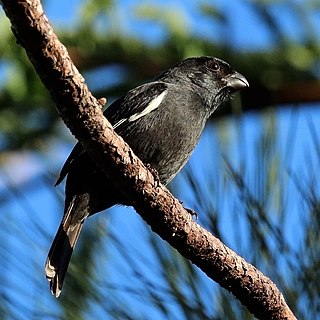
Melopyrrha is a genus of passerine birds in the tanager family Thraupidae. It is made up of four extant species endemic to the Greater Antilles, along with 1 possibly extinct species from the island of Saint Kitts in the Lesser Antilles.
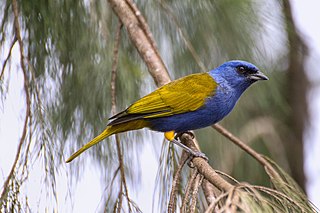
The blue-capped tanager is a species of bird in the tanager family Thraupidae. It was formerly placed in the genus Thraupis but is now the only species in the genus Sporathraupis.

The Cuban grassquit is a small bird in the tanager family Thraupidae. It is endemic to Cuba.

The western chat-tanager is a Vulnerable species of passerine bird belonging to the family Calyptophilidae. It is endemic to the island of Hispaniola which is shared by the Dominican Republic and Haiti.

Loriotus is a genus of birds in the tanager family Thraupidae. The species now placed in this genus were formerly placed in the genus Tachyphonus.
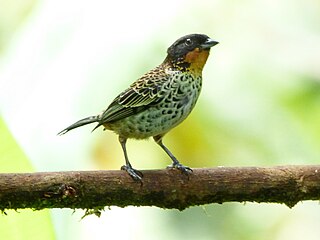
Ixothraupis is a genus of Neotropical birds in the tanager family Thraupidae.




















